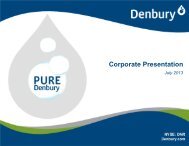Interactive 2009 Annual Report (PDF 7.56 MB) - Denbury Resources ...
Interactive 2009 Annual Report (PDF 7.56 MB) - Denbury Resources ...
Interactive 2009 Annual Report (PDF 7.56 MB) - Denbury Resources ...
- No tags were found...
You also want an ePaper? Increase the reach of your titles
YUMPU automatically turns print PDFs into web optimized ePapers that Google loves.
<strong>Denbury</strong> <strong>Resources</strong> Inc. <strong>2009</strong> <strong>Annual</strong> <strong>Report</strong> 15interests have estimated proved conventional reserves of approximately 18.5 M<strong>MB</strong>bls at December 31, <strong>2009</strong>, nearly allof which are proved developed. The Conroe Field assets are currently producing around 2,500 BOE/d net to ouracquired interest. We will need to build a pipeline to transport CO 2 to this field, preliminarily estimated to cover 80 miles,as an extension of our Green pipeline. Based on our preliminary estimates, <strong>Denbury</strong> will spend an additional $750million to $1.0 billion, including the cost of the CO 2 pipeline, to develop the Conroe Field as a tertiary flood. Thedevelopment of this tertiary flood is not expected to begin for four or five years.Delhi Field. During May 2006, we purchased the Delhi Holt-Bryant Unit (“Delhi”) in Northern Louisiana for $50 million,plus a 25% reversionary interest to the seller after we achieve $200 million in net operating income. We began well workdevelopment in 2008 and drilled or recompleted additional wells in <strong>2009</strong> and built a processing facility. We begandelivering CO 2 to the field in the fourth quarter of <strong>2009</strong> via the recently completed Delta Pipeline (Tinsley to Delhi).Based on early indications, the first enhanced oil production response is anticipated mid-2010. Our 2010 capital plansfor the Delhi Field include the drilling of 26 wells and the workover or re-entry of an additional 30 wells. As of December31, <strong>2009</strong>, there was no significant oil production nor proved tertiary oil reserves at Delhi Field.Hastings Field. During November 2006, we entered into an agreement with a subsidiary of Venoco, Inc. that gave usan option to purchase their interest in Hastings Field, a strategically significant potential tertiary flood candidate locatednear Houston, Texas. We exercised the purchase option prior to September 2008, and closed the $201 millionacquisition during February <strong>2009</strong>. As consideration for the option agreement, we made total payments of $50 million.The purchase price of $201 million included approximately $4.9 million for certain surface land, oilfield equipment andother related assets. Under the terms of the agreement, Venoco, Inc., the seller, retained a 2% override andreversionary interest of approximately 25% following payout, as defined in the option agreement. During the fourthquarter of <strong>2009</strong>, production from Hastings Field averaged 1,983 BOE/d, with conventional proved reserves atDecember 31, <strong>2009</strong> of approximately 8.9 M<strong>MB</strong>OE. We plan to commence flooding the field with CO 2 beginning in late2010 or early 2011, after completion of our Green Pipeline currently under construction.Based on preliminary engineering data, the West Hastings Unit (the most likely area to be initially developed as atertiary flood) has significant net reserve potential from CO 2 tertiary floods, the second largest reserve potential of anyother single field in our inventory. We started construction of the Green Pipeline during November 2008 to transportCO 2 to this field (see “CO 2 Pipelines” above). Based on our latest estimates, it will cost between $400 million and $600million to develop the West Hastings Unit as a tertiary flood, excluding the cost of the Green Pipeline.Oyster Bayou, Fig Ridge and Gillock Fields. During 2007, we acquired an interest in three fields in Southeast Texaswith significant tertiary potential. The Oyster Bayou and Fig Ridge Fields are located in close proximity to each otherand are located on or close to the Green Pipeline. We acquired the majority interest in Oyster Bayou Field and arelatively small interest in Fig Ridge Field. We initiated unitization hearings at Oyster Bayou Field during <strong>2009</strong>. Becauseof current lack of majority interest at Fig Ridge Field, we will need the cooperation of other operators and lease ownersto form the necessary unit. We plan to commence flooding the Oyster-Bayou Field with CO 2 beginning in mid-2010.Our acquisitions in Gillock Field include an acquisition of almost all of the South Gillock Unit, the Southeast Gillockunit and the acquisition of a key lease in the Gillock Field. The Gillock acquisitions are located near the proposed GreenPipeline and Hastings Field. <strong>Denbury</strong> continues to evaluate potential acquisition candidates in Southeast Texas and inLouisiana in proximity to our Green Pipeline and near our pipelines in Mississippi.Overall Tertiary Economics to Date. Through December 31, <strong>2009</strong>, we have invested a total of $1.8 billion on tertiaryoil fields (including the allocated acquisition costs and amounts assigned to Goodwill), and received $1.6 billion in netoperating income (revenue less operating expenses), or net unrecovered cash flow of $225.7 million, the deficit primarilydue to the significant funds expended on acquisitions during <strong>2009</strong>. Of our total spending, approximately $487.4 millionwas invested to date on fields that had little or no proved reserves at December 31, <strong>2009</strong> (i.e., significant incrementalproved reserves are anticipated in future years). These amounts do not include the capital costs or related depreciationand amortization of our CO 2 producing properties at Jackson Dome, which had an unrecovered net cash flow of$1.4 billion as of December 31, <strong>2009</strong>, including $1.1 billion associated with CO 2 pipelines. At year-end <strong>2009</strong>, the provedoil reserves in our tertiary recovery oil fields had a PV-10 Value of approximately $2.3 billion, using 12-month first-dayof-the-monthunweighted average NYMEX pricing of $61.18 per barrel. In addition, there are significant probable andpossible reserves at several other fields for which tertiary operations are under way or planned.Form 10-K Part I




